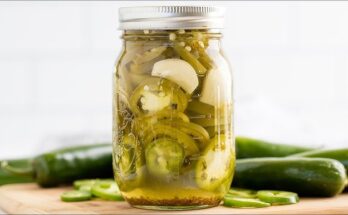Raspberry Sauce Recipe: Raspberry sauce is that magical ruby-red drizzle that can turn an ordinary dessert into a showstopper. It’s sweet, tangy, and bursting with the fresh flavor of ripe raspberries. Whether you’ve seen it swirled over cheesecakes, dripping down a stack of pancakes, or spooned over vanilla ice cream, it’s a versatile condiment that adds a fruity punch wherever it goes. What makes raspberry sauce stand out is its vibrant color, rich texture, and a flavor that strikes the perfect balance between tart and sweet.
The best part? It’s incredibly simple to make. No fancy ingredients. No complicated techniques. Just a handful of pantry staples and fresh (or frozen) raspberries are all you need. In just 15 to 20 minutes, you can have a homemade sauce that’s better than anything you’ll find in a store-bought jar.
Why Make Raspberry Sauce at Home?
Let’s be real—store-bought raspberry sauces can be a hit or miss. Many are packed with preservatives, artificial flavors, or an overload of sugar that overpowers the delicate fruit flavor. Making it at home gives you full control over every ingredient. You decide how sweet it is, how thick it becomes, and whether you want seeds in or out.
Homemade raspberry sauce is also incredibly cost-effective, especially if you have access to fresh berries in season or you stock up on frozen ones during a sale. Plus, it’s customizable. Want it a little spicy? Add a pinch of chili. Craving a citrus twist? A splash of orange juice will do. You can tailor it to your preferences with ease.
And did we mention the aroma? When raspberries simmer on the stove, the kitchen fills with the irresistible scent of summer. It’s pure joy in a saucepan. Now let’s dive into what you’ll need to make your own.
Ingredients Needed
Fresh vs. Frozen Raspberries
You can make raspberry sauce with either fresh or frozen raspberries, and both will give you a tasty result. If it’s raspberry season, nothing beats the flavor of fresh berries. They’re naturally sweet, deeply fragrant, and give your sauce a vibrant taste.
But don’t worry if you don’t have access to fresh raspberries. Frozen berries work beautifully, and they’re often flash-frozen at peak ripeness, meaning they retain much of their flavor and nutrients. Just make sure to thaw them slightly before cooking for even heat distribution.
Pro tip: Use organic raspberries if possible, especially if you’re leaving the skins and seeds in the sauce. They’re free from pesticides and usually have a richer taste.
Sweeteners and Flavor Enhancers
Here’s a basic list of ingredients for a classic raspberry sauce:
- 2 cups raspberries (fresh or frozen)
- 1/2 cup granulated sugar (adjust to taste)
- 1 tablespoon lemon juice (for brightness)
- 1 teaspoon cornstarch mixed with 1 tablespoon water (optional, for thickening)
- A pinch of salt (to balance the sweetness)
You can substitute sugar with honey, agave syrup, or even a zero-calorie sweetener like stevia if you’re watching your sugar intake. Lemon juice not only enhances the tartness but also acts as a natural preservative.
Feeling creative? Add a splash of vanilla extract, a grating of lemon zest, or even a touch of balsamic vinegar for a complex flavor twist.
Tools You’ll Need
Basic Kitchen Tools
You don’t need to be a professional chef to make raspberry sauce, but having the right tools can make things smoother. Here’s a quick checklist:
- Medium saucepan
- Wooden spoon or silicone spatula
- Fine mesh strainer (for removing seeds, if desired)
- Measuring cups and spoons
- Mixing bowl (for straining and cooling)
These are kitchen staples, and you probably already have most of them. If you’re making a larger batch, consider using a larger pot to avoid bubbling over.
Optional Gadgets for a Smoother Sauce
If you want that super-silky restaurant-style sauce, a few optional gadgets can help:
- Blender or immersion blender (to puree before straining)
- Fine chinois or food mill (for ultra-smooth texture)
- Mason jars or glass containers (for storage)
Using a blender helps break down the raspberry seeds and skins before you strain the sauce. This results in a smoother finish without sacrificing flavor.
Step-by-Step Raspberry Sauce Recipe
Step 1: Prepare Your Ingredients
First things first—gather everything you need. Wash your raspberries gently under cold water if they’re fresh. If using frozen, let them thaw for about 10 minutes. Measure out your sugar, lemon juice, and any additional flavorings you’d like to try. Combine your cornstarch and water in a small bowl if you’re using it.
Preparation is key to a stress-free cooking process. You don’t want to be scrambling to find your strainer while the sauce is bubbling on the stove.
Step 2: Cooking the Raspberries
Place the raspberries and sugar into a saucepan over medium heat. Stir gently to combine and let the berries start to break down. After a few minutes, they’ll release their juices, creating a fragrant, bubbling mixture.
Let it simmer for about 5 to 7 minutes, stirring occasionally to prevent sticking. If you’re adding lemon juice or other flavor enhancers, now’s the time to stir them in. If you’re using cornstarch to thicken the sauce, add the slurry (cornstarch + water) and continue stirring until it thickens slightly.
The sauce should be slightly glossy and pourable—not too thick, not too runny.
Step 3: Sweetening and Enhancing Flavor
Now that your raspberries have softened and started to release their juices, it’s time to bring out their full flavor potential. At this stage, taste the sauce and adjust the sweetness if needed. Some berries are naturally sweeter than others, so don’t be afraid to add a bit more sugar—or reduce it—based on your personal preference.
Add lemon juice to brighten the flavor. This small splash of citrus adds a tangy depth that perfectly balances the natural sweetness of the raspberries. If you like a more complex flavor profile, try adding:
- A dash of vanilla extract for warmth
- A few drops of almond extract for nuttiness
- A splash of balsamic vinegar for an elegant twist
Continue simmering the mixture on low heat for another 2 to 3 minutes, allowing the added flavors to meld beautifully with the berries. Stir regularly to prevent burning.
Pro tip: Always taste as you go. It’s the easiest way to ensure you’re building layers of flavor that suit your palate.
Step 4: Straining for a Smooth Texture
This is the step that separates a rustic berry compote from a glossy, gourmet-style raspberry sauce. While the seeds are edible and some folks enjoy the texture, others prefer a silky-smooth finish.
Place a fine mesh strainer or sieve over a bowl. Carefully pour your cooked raspberry mixture through the strainer. Use a spoon or spatula to gently press the pulp through the mesh, leaving the seeds behind. This part can take a few minutes but is well worth the effort if you’re after that luxurious texture.
Don’t forget to scrape the bottom of the strainer to get every last drop of the good stuff. Discard the seeds (or save them to toss into smoothies or yogurt if you’re feeling eco-conscious).
You should now have a beautiful, smooth, jewel-toned raspberry sauce ready for the final stage.
Step 5: Cooling and Storing the Sauce
Once your sauce is strained and smooth, let it cool at room temperature for about 10–15 minutes. The sauce will continue to thicken slightly as it cools. If you want a thinner consistency, you can stir in a tablespoon or two of water or fruit juice at this point.
When cooled, transfer the sauce to a clean jar or airtight container. It will keep in the refrigerator for up to a week, making it easy to prep ahead for desserts or breakfast toppings.
For longer storage, raspberry sauce freezes beautifully. Pour it into freezer-safe containers or ice cube trays (for single servings), and freeze for up to 3 months. Just thaw in the fridge overnight when you’re ready to use it.
Pro tip: Label your containers with the date, so you always know how fresh your sauce is.
Serving Suggestions
Perfect Pairings for Raspberry Sauce
So now that you’ve made this delightful sauce, what should you drizzle it on? Raspberry sauce is incredibly versatile and pairs well with both sweet and savory dishes. Here are some delicious ideas:
- Desserts: Pour it over cheesecakes, panna cotta, or chocolate lava cakes.
- Breakfasts: Drizzle on pancakes, waffles, French toast, or oatmeal.
- Ice Cream: A classic combo—vanilla ice cream topped with warm raspberry sauce is heaven.
- Yogurt and Granola: Swirl it into Greek yogurt for a fruity kick.
- Baked Goods: Use it as a filling for cakes, cupcakes, or between macaron shells.
Creative Ways to Use It
Want to take things up a notch? Here are some more inventive uses:
- Mix with balsamic vinegar for a fruity salad dressing.
- Use as a glaze for grilled chicken or pork.
- Stir into cocktails or mocktails for a raspberry twist.
- Add a spoonful to sparkling water for a refreshing summer drink.
- Layer it in parfaits or trifles for a visually stunning treat.
No matter how you serve it, this raspberry sauce adds instant flair and flavor.
Storage and Shelf Life
How Long Does Raspberry Sauce Last?
Raspberry sauce may be simple to make, but storing it properly ensures you can enjoy it over time without losing its flavor or freshness. If stored correctly in the refrigerator in an airtight container, homemade raspberry sauce typically lasts up to 7 days. It’s important to always use a clean spoon when serving to avoid introducing bacteria, which can cause it to spoil faster.
Keep an eye on changes in color, texture, or smell. If the sauce begins to smell sour, develops mold, or separates oddly, it’s time to toss it. Labeling your jars with the date helps you track freshness easily.
Pro tip: For best results, let the sauce cool completely before sealing the container. This prevents condensation inside the jar, which can dilute the sauce and affect its longevity.
Freezing Tips for Long-Term Storage
Want to extend the life of your raspberry sauce? Freezing is the way to go. Here’s how to do it effectively:
- Cool completely: Make sure your sauce is at room temperature before freezing.
- Use freezer-safe containers: Glass jars with wide mouths or BPA-free plastic containers work best.
- Leave space at the top: The sauce will expand as it freezes, so leave about ½ inch of space to avoid cracked containers.
- Portion it out: Freeze in small batches or ice cube trays for easy use in recipes or drinks.
Frozen raspberry sauce can last up to 3 months in the freezer. When ready to use, simply thaw in the refrigerator overnight or place the container in a bowl of warm water for quicker defrosting.
Bonus tip: Add a little lemon juice or sugar before freezing to help preserve color and flavor.
Common Mistakes to Avoid
Overcooking the Sauce
It’s tempting to walk away and let the sauce simmer while multitasking in the kitchen. But overcooking is one of the quickest ways to ruin your raspberry sauce. Raspberries are delicate and cook quickly—boiling them too long can break down their natural pectin and result in a syrupy or overly thick consistency with a dull flavor.
Signs you’ve overcooked it:
- Sauce turns too dark (almost purplish-black)
- Taste becomes bitter or overly concentrated
- Texture feels sticky or gummy
To avoid this, always cook on medium to low heat, and keep a close eye. Stir frequently, and as soon as the berries start to break down and release juice, you’re halfway there.
Not Straining Properly
If you’re going for a seedless sauce, straining is essential. But doing it hastily can lead to one of two issues:
- You don’t extract enough liquid, wasting good sauce
- You push too hard, forcing seeds or skins through the mesh, making it gritty
The solution? Use a fine mesh sieve and take your time. Press gently but thoroughly. Scraping the underside of the strainer collects every bit of smooth sauce.
If you want an ultra-luxurious texture, consider running it through a food mill or chinois. You’ll be amazed at the difference in quality when straining is done right.
Health Benefits of Raspberries
Nutritional Value
Aside from their irresistible taste, raspberries are packed with nutrients that make your sauce not just delicious but also healthy (in moderation, of course). One cup of fresh raspberries provides:
- Fiber: 8 grams, which is excellent for digestion
- Vitamin C: More than 50% of your daily recommended intake
- Manganese: Supports bone health and metabolism
- Antioxidants: Such as quercetin and ellagic acid
What does this mean for your raspberry sauce? It’s a treat you can feel good about. While you’ll likely add sugar to balance the tartness, the fruit itself brings a nutritional punch.
Antioxidants and Their Role
Raspberries are one of the top antioxidant-rich fruits, meaning they help neutralize free radicals in the body. Free radicals are unstable molecules that can contribute to aging and chronic diseases when left unchecked.
Antioxidants in raspberries have been studied for their potential to:
- Fight inflammation
- Protect heart health
- Improve blood sugar levels
- Support brain function
Even when cooked, many of these benefits remain intact. So, whether you’re drizzling raspberry sauce over ice cream or stirring it into oatmeal, you’re doing more than treating your taste buds—you’re giving your body a boost too.
FAQs about Raspberry Sauce Recipe
Can I make raspberry sauce without sugar?
Yes! You can substitute sugar with honey, maple syrup, agave nectar, or a sugar-free alternative like stevia. Just adjust the quantity to taste, as some sweeteners are more potent than others.
How do I thicken raspberry sauce?
You can thicken your sauce using a cornstarch slurry (1 teaspoon cornstarch mixed with 1 tablespoon cold water). Add it while the sauce simmers and stir until it reaches your desired consistency.
Is raspberry sauce gluten-free?
Absolutely. Raspberries and sugar are naturally gluten-free. Just ensure that any added thickeners like cornstarch are certified gluten-free if you’re cooking for someone with celiac disease or sensitivity.
What can I use instead of lemon juice?
You can use lime juice, orange juice, or even a splash of vinegar like apple cider or white balsamic to add acidity and brighten the flavor.
Can I use this sauce for canning?
While this sauce is delicious, it’s best consumed fresh or frozen. For canning, a specific recipe that ensures food safety through proper acidity and sterilization is recommended.
Conclusion
Raspberry sauce isn’t just another condiment—it’s a game-changer in your kitchen. Sweet, tangy, and beautifully vibrant, it can elevate any dish from simple to spectacular. Whether you’re spooning it over cheesecake, swirling it through yogurt, or using it as a glaze for meats, the possibilities are endless.
By following this easy step-by-step guide, you’ll have a reliable, customizable, and utterly delicious raspberry sauce that beats anything from the store. With its short cook time, simple ingredients, and long shelf life, it’s the kind of recipe you’ll return to again and again.
Plus, with the added bonus of raspberries’ nutritional benefits, it’s a treat you can indulge in with a little less guilt. So go ahead—make a batch, experiment with flavors, and discover just how versatile this fruity sauce can be.



